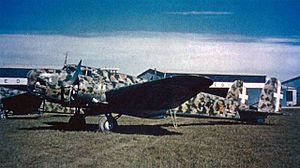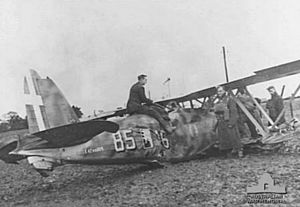Corpo Aereo Italiano facts for kids

The Corpo Aereo Italiano (pronounced: KOR-po ah-EH-reh-o ee-tah-lee-AH-no), also known as the CAI, was a special air force group from Italy. It was part of the Italian Royal Air Force (Regia Aeronautica). This group helped Germany during the Battle of Britain and the Blitz in late 1940, during World War II. The CAI worked with the German Air Force (Luftwaffe) and flew against the British Royal Air Force (RAF) and Fleet Air Arm (FAA). The CAI had some small successes, but its planes were often not as good as the British ones.
Contents
How the CAI Was Formed
The Italian leader, Benito Mussolini, wanted to help his German ally during the Battle of Britain. So, he decided to send a part of the Italian Royal Air Force.
On September 10, 1940, the CAI was officially created. It was led by Generale di Squadra Aerea Rino Corso-Fougier.
The Planes They Used
The CAI used several types of planes:
- Fiat CR.42 from the 18° Gruppo. This Italian CR.42 was a fast and easy-to-fly biplane fighter. Even though it was quick (over 440 km/h), it was older than the British Hurricanes and Spitfires. These British planes were faster and had better weapons.
- Fiat G.50 Freccia from the 20° Gruppo. This Italian G.50 monoplane fighter could not fly very far (about 400 miles or 640 km). Many of these planes also did not have a radio, which made it hard for pilots to talk to each other.
- Fiat BR.20 bombers from the 13° and 43° Stormo. The Italian BR.20 was a bomber with two engines. It could carry a lot of bombs, about 1,600 kg (3,530 lb).
Other planes helped too. Six CANT Z.1007bis planes were used for looking around (reconnaissance). Caproni Ca.133 planes were used for transport.
On September 25, the bombers arrived at their airfield in Melsbroek, Belgium. Their trip was difficult, with some planes having to land early or even crash because of problems or bad weather. The fighter planes arrived later. The 50 Fiat CR.42s were based at Ursel, and the 45 Fiat G.50s were at Flugplatz Maldegem, both in Belgium.
What They Did
The CAI flew its first mission on the night of October 24/25, 1940. Eighteen BR.20 bombers took off to attack Harwich and Felixstowe in Britain. Not all planes found their targets, and three were lost in accidents.
The next big mission for the CAI was on October 29. Some historians say this was the last day of the Battle of Britain. Fifteen BR.20 bombers, with many fighter planes protecting them, bombed Ramsgate during the day. The Italian bombers flew in a neat line, wingtip to wingtip. Their fighter escorts, with open cockpits and fixed landing gear, flew in a similar perfect order. The planes were painted light sand yellow with green and red-brown spots. This camouflage was better for hotter places than for Britain in late October. Five Italian planes were damaged by anti-aircraft guns. One bomber dropped three bombs near the Royal Marine Depot in Deal, Kent, killing several people.
The next few days saw several smaller attacks.
On November 11, 1940, the CAI had its first big fight against the RAF. Ten bombers were flying with forty-two CR.42s, G.50s, and some German Messerschmitt Bf 109s. The G.50s had to turn back because of bad weather and not enough fuel. So, only the CR.42s were left to protect the bombers. However, British Hurricanes from several squadrons attacked them. The British planes destroyed three bombers and two fighters. Another Italian plane was lost due to a problem or getting lost, and its pilot was captured. Also, four bombers had to land early, two fighters were destroyed when they landed, and eight more fighters landed with damage. Over 20 Italian airmen were missing, dead, or hurt. The British had only two fighters slightly damaged. One of the Italian CR.42s was later fixed by the British and studied. It is now in a museum in the UK.
Fighter plane battles were also difficult for the CAI. On November 23, 29 Italian fighters were flying near the South Foreland. British Spitfire Mk.IIs surprised the Italian biplanes. Two Italian planes were shot down, and several others were damaged. Only one British Spitfire was damaged in return.
The CAI continued to carry out bombing raids, mostly on the Harwich and Ipswich areas.
By the end of December, before they moved, the CAI had flown 97 bombing missions. They lost three planes. The Italian planes dropped about 45 tonnes of bombs, mostly at night over Harwich.
Between October 1940 and January 1941, the CAI fighters flew 454 attack missions and 480 defense missions. This included 113 missions protecting bombers.
Moving On
In early January 1941, all the bombers and biplanes of the CAI were moved to other places. Only the Fiat G.50s remained until mid-April 1941, when they also left.
From January to April 1941, the two remaining squadrons in Belgium flew another 662 defense missions.
Biplane vs. Monoplane
Even though the main fighter plane used by the CAI was a biplane, which is an older type of plane, it was not always worse than the newer monoplanes. On November 11 and 23, 1940, CR.42s flew missions over Great Britain. The German Luftwaffe planes had trouble flying with the slower Italian biplanes. However, the Falcos (as the CR.42s were called), even though they were slower, had an open cockpit, no radio, and only two machine guns, could turn much tighter than Hurricanes and Spitfires. This made them very hard to hit.
One pilot said, "The CR 42 turned to fight using all the aeroplane's manoeuvrability. The pilot could get on my tail in a single turn, so tightly was he able to pull round." British reports also said the Falcos were tough targets. "As I fired he half rolled very tightly and I was completely unable to hold him, so rapid were his manoeuvres."
Against British monoplanes, the CR.42s were not always outclassed. One Italian pilot said, "I realised that in a manoeuvered flight, the CR.42 could win or survive against Hurricanes and Spitfires, though we had to be careful of a sweep from behind." He also noted that the British bullets did not always cause much damage.
Summary of Bombing Missions
Here is a summary of the CAI's bombing missions:
| Date | Targets | Bomber Flights | Fighter Flights | Notes |
|---|---|---|---|---|
| October 25 (night) | Harwich | 16 | – | One plane crashed, two crews left planes due to low fuel. |
| October 29 (day) | Ramsgate | 15 | 73 | Many planes slightly damaged by anti-aircraft fire. |
| November 5 | Harwich | 8 | – | |
| November 11 (day) | Harwich | 10 | 40 | Three bombers and two fighters shot down; 10 fighters damaged on landing. |
| November 17 (night) | Harwich | 6 | – | |
| November 20 (night) | Harwich, Ipswich | 12 | – | |
| November 29 (night) | Ipswich, Lowestoft, Great Yarmouth | 9 | – | |
| December 14 (night) | Harwich | 11 | – | |
| December 21 (night) | Harwich | 6 | – | |
| December 22 (night) | Harwich | 4 | – | |
| January 2 (night) | Ipswich | 5 | – | |
| Totals | 102 | 113 | Bombs dropped: 9.4 tonnes by day, 44.9 tonnes by night. |
See also
- Military history of Italy during World War II
- RAF Fighter Command



